

|
|
|
|
|
|
|
|
|
|
|
|
|
|
| During the course of pursuing my
architectural studies, I had visited several places in this region. If
I had the resources I would like to visit more places around the world.
Any sponsors? |
| Singapore, being the closest Malaysian neighbour, is the most visited city outside Malaysia by me. As I said earlier, my rendezvous with the Lion City begins quite early in my live. |
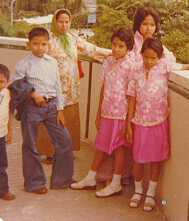 |
Early photo of our family Singapore trip. I'm not sure where exactly
the photo was taken from. Look at me. Oh my God. What am I thinking then?
All my sisters were wearing co-ordinated number in pink, M@k's creations!
The difference of the three design are the collar. @tih is sporting cheongsam
style. El@ with cekak musang and @cik with ... what was that? Stanford
Raffles collar? |
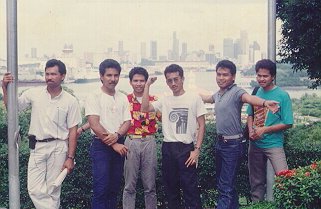 |
The photo was taken on Sentosa Island. I was in my final year Diploma in Architecture in ITM. This was our first introduction to Urban Design. Singapore is one of the city in the world which implement very strict urban design guidelines. That why the city look very organise, clean and well planed. Sometimes, I feel that it was too well planned it's become regimented and... cold. There are always something telling you what to do. Signboards, arrows, warning signs etc. Don't do this. Don't go there. Walk here. See this. Flush after you finished, etc. |
 |
Singapore city is as green as Kuala Lumpur. There are many parks and
open spaces. The photo was taken from one of such parks in the marina bay
area. In the background is Singapore city skyline. I was in my second year
Advance Diploma and I went with my junior from the final year Diploma.
They were studying the MRT stations for their design project; The KL LRT
stations. Me? I just tag along. |
 |
On the balcony of the penthouse office at Ngee Ann City on Orchard
Road. The office tower is still under construction (final stage). As usual,
we give the guard a slip and went into one of the working lift and when
straight up. We took the firemen's lift because we know that only that
lift stop at every floor. Although we met with a few workers, we were not
stopped or question. The art of trespassing: always act as if you know
were you're going and be cool!
From front, Gina, As, Mie, me and Oman. |
| I went to Bali in January 1997. I stayed at Mabisa Beach Resort in Kuta. I spend 5 days visiting Sanur, Bedugul, Cintamani, Tanah Lot, Nusa Dua etc. It was a unique experience. The beaches are nothing to shout about. However, the people, culture and buildings are fascinating. I definitely will visit Bali again , if I can afford it. |
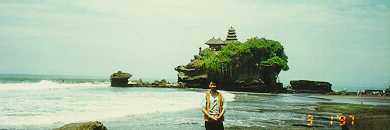 |
Pura Tanah Lot. During high tide, the Pura (temple) will become an island. Many visitor's come here to see the sun set behind the Pura. |
 |
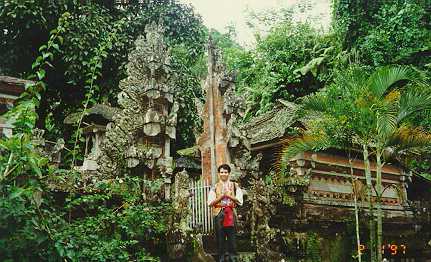 |
|
|
|
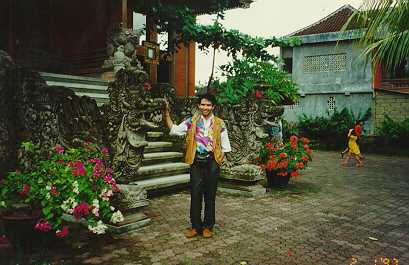 |
 |
|
|
|
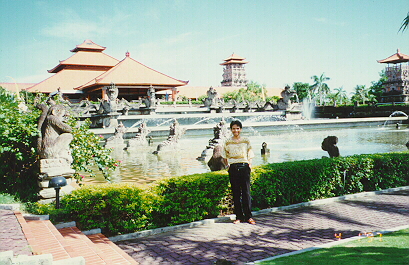 |
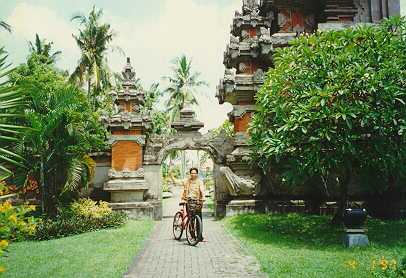 |
|
|
|
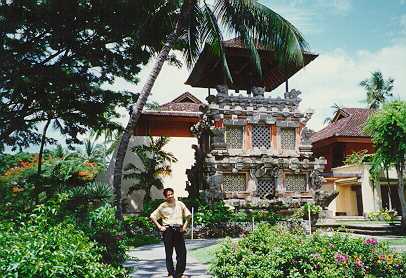 |
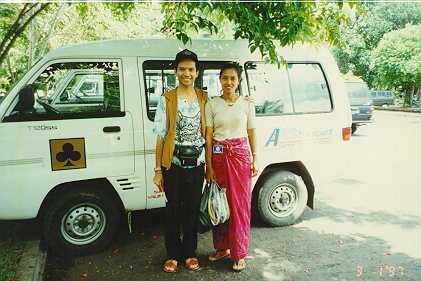 |
|
|
|
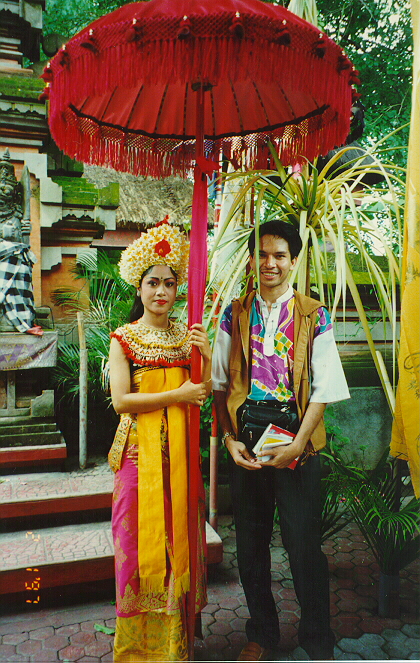 |
After watching the traditional dance (a kind like Barongan), I took the opportunity to pose with one of the dancer. |
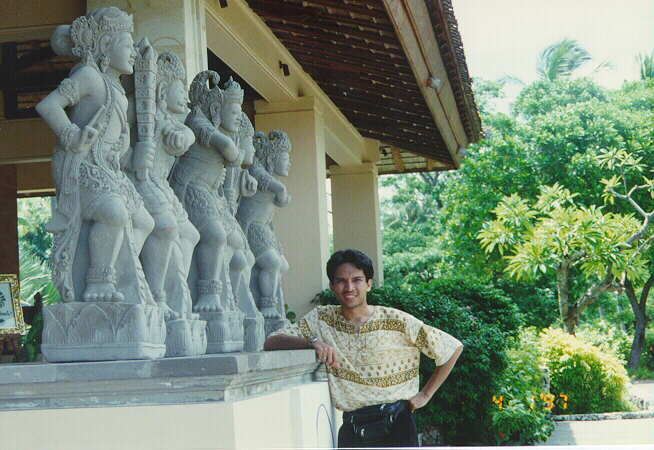 |
|
|
| In October 1991, I had the opportunity to travel to Pakistan on a PAM travel scholarship. I was representing Malaysia at the 4th Architectural Student Jamboree in Lahore. This was my first time going abroad on a plane. Since I was travelling alone (well, not actually alone; I got the other Malaysian architect on the same flight. Mr. P. Kasi, Mr. Jimmy Lim, Ms. Nina Wong... and the famous Ms. Fay Cheah to keep me company) to Pakistan, I committed many mistakes. However, in the end, it turns out to be very funny. The first mistake I made were using a luggage bag with no lock. The drawings that were forced to me by PAM were also not seal properly, so I had to carry along with me on the plane. |
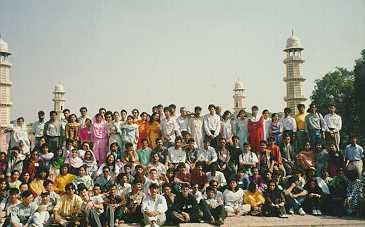 |
|
| Lahore City. The photo was taken in front of the meat market. It was
closed on Wednesday because according to the student guide, Wednesday had
been declared 'no red meat day'.
In the background you can see people participating in a protest march in conjunction with mmm.. Black Friday? I'm not sure (the day Kashmir fall to the Indian forces). Anyway the atmosphere were tense. But not for us. We continue acting like 'stupid tourist' taking photograph, shopping, etc. However, the Philippines delegate were not lucky enough and were tear gassed by the police. |
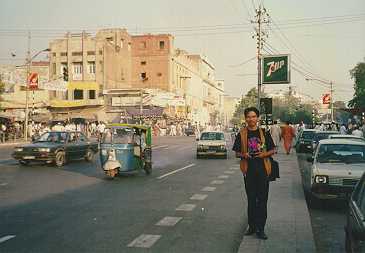 |
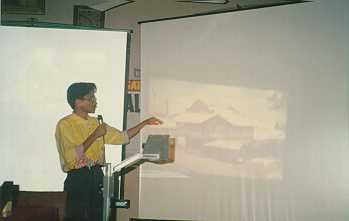 |
The issue discussed in the seminar was 'Vernacular Architecture in
the 20th Century'. It was divided into 3 sections: the past, the present
and the future. Can you believe it? I was actually giving a seminar on
vernacular architecture in Malaysia to a whole bunch of Architectural student
from all over Asia! My...
I do not even prepare any script. With the help of a slide projector, I showed 3 sample of architecture in three different part of Malaysia i.e.. Melaka, Penang and Kuala Lumpur. However apparently they like my presentation and ask me to continue in another informal session organise by the student in the evening. |
| A group of excited and very friendly Pakistani girls posing with us. The long haired guy is Samidirijono. Next to him is Gunawan and Guruh (at the back). They are from Indonesia. I really hope I got their names right. Pakistani girls had very strong feature. Some of them look like they just come out of the Hindustani movie screen. Sharp nose, thin lips, blue eyes, long haired and ...tall! They look very beautiful and sometimes cute in their Salwar Kamees, long scarves and 'Reebok' shoes (at least most of the students from Lahore National College of Art wear that shoes then). | 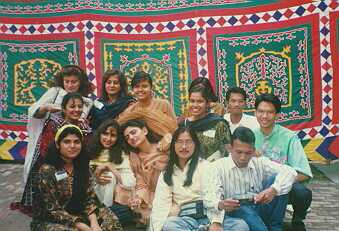 |
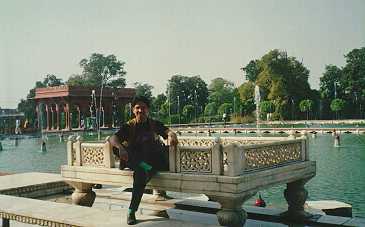 |
Posing on the Marble throne at Shalamar Garden. It was built during Jahangir Khan era and improved by Shah Jahan with his trademark use of marble. |
| I'm standing in front of the entrance to Lahore Fort. It is situated opposite the Badshahi mosque. If I'm not mistaken, the gate is also called 'The Elephant Gate'. I can't argue with that! | 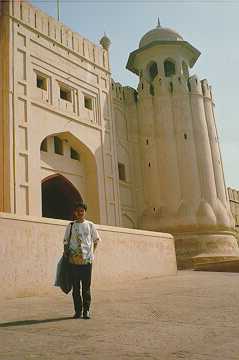 |
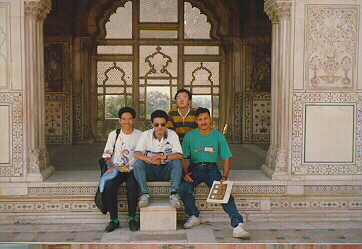 |
Inside Lahore Fort. Nadeem Daar, the guy with the green T shirt is
one of the three 'body guards cum tour guide' assigned to me. I'm not really
sure who the guy in the cool shade were, but I knew he is from Pakistan.
The guy at the back is Kim, from South Korea.
This potion of the fort was built by Shah Jahan. The marble screen at the back is called 'Mas Rabia'. |
| At the entrance of Badshahi mosque. Tabasum Ali (Pakistan) me, Shanker and Prakesh (Sri Lanka) | 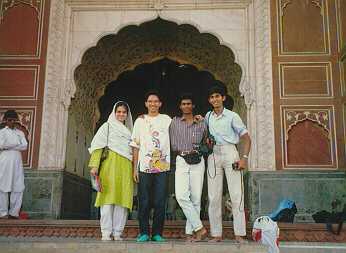 |
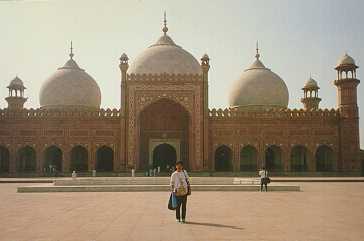 |
Badshahi Mosque. One of the biggest courtyard mosque in the world.
It was built by Emperor Aurengzeb. Its a combination use of marble and
red sandstone. It is definitely one of the most beautiful mosque I had
ever visited.
In the centre of the courtyard, you can see the huge water tank/pool for ablution purposes. |
| On the steps to the inner sanctuary of the mosque. My friend Aw Eng Pock is one of the Singapore delegate. He study architecture in National University of Singapore (NUS). He actually from Ipoh. | 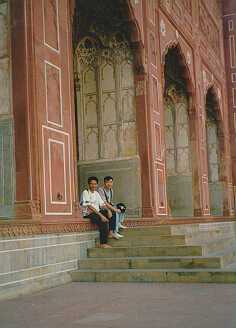 |
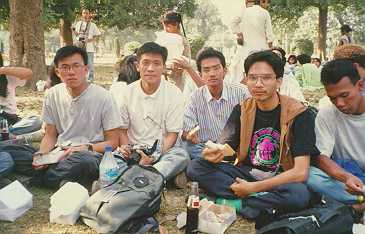 |
I become very
close with many of the delegates, especially with the Indonesian and Singaporean,
because we speak the same language (Manglish/Singlish!).
Although it was only for seven days, it's left me with memories to last a lifetime. After coming back from Pakistan, the urge to travel to other destinations becomes stronger. Sandra Rhinta is one of the Indonesian. |
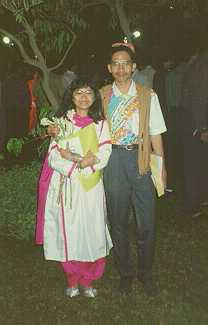 |
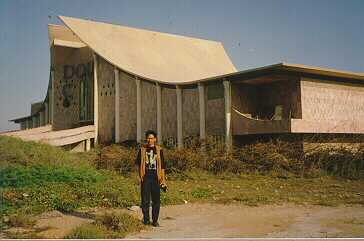 |
It was actually
my mistake. I told Ms. Fay Cheah who arrange for the flight ticket that
I would like to take a tour in Karachi en route to Singapore after the
conference. I did not expect at all that she arrange for my flight to transit
in Karachi for one night. All along I thought my flight will be the same
day when I arrive in Karachi, only much latter.
Luckily I met with this wonderful Pakistani student on the plane from Lahore to Karachi. When we reach Karachi airport at noon, he offer to show me around Karachi before my flight that I thought were due at midnight that same day. It turns out that my flight is only on the next day! So he took the embarrassed me to his house for the night. His parent's is kind enough to provide me with food and even brought me along to witness a wedding reception. |
| The next day
he show me around Karachi some more. The building above were actually a
casino by the sea side. However when Gen. Zia Ul Haq took power from Bhuto,
he closed all casino in Pakistan. So the building was left just like that.
The photo on the right is supposed to be one of Jinnah's house that was to be converted to a museum. Well, apparently work had not started. The guy standing next to me is one of the student coming back from the conference. He is from Palestine studying in Karachi. and send me back to the airport 2 hours before my flight back to Malaysia. |
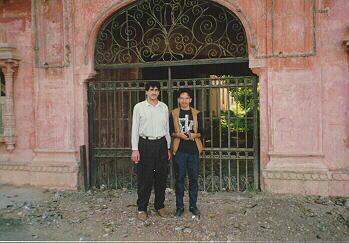 |
| My India trip was more like a coincidence than a properly planed journey. Anyway, all my other trips were also unplanned. I was working at KAZT at that time. My boss asks me to go with him to India to interview Indian architect who apply to work with us. We were supposed to be in India by Friday 27th June 1997. The Indian had applied through their agent in Kuala Lumpur. At that time, Malaysia is facing acute shortage of workers, be it professional or semi-skilled workers. Population of 20 million cannot support demand of workforce needed in the current economic development (unemployment rate in 1997 Malaysia was 2% which most unemployed was by choice). All expenses to interview prospective candidates in Delhi will be borne fully by the agencies. In return, successful candidates will have to pay commission to them. I had browse through most of their resume. More than 30 of them. Most of them are quite impressive with Masters Degree and years of working experienced. They will be surprise to find out that they will be interview by a much younger architect like my boss and me! That's the miracle of the economy. |
| I do notice however that most of them work on smaller scale project. Interior design, renovation, villa, resort, etc. None of them had experience in mega project like shopping malls and condominiums with built up area more than 2 million square feet and cost more than RM150 million, like what we are handling now. Furthermore, I can bet that most of them are not used of the fast trekking construction system that most developer undertakes now. In Malaysia (1997), the speed of the construction of a project is mind boggling. We will get our plan approved by the relevant authority from 1 week to 3 month! Tender calling will be done immediately after building approval was obtained. Sometimes, no tender was called. Instead the developer go for the concept of ‘turn-key’ or ‘built-transfer’ or ‘built-operate-transfer’. That's explained how the tallest building in the world was completed in only 18 month. |
| Malaysian government imposes high levy to foreign workers to protect locals. Levy will be paid by the employer and normally deducted from the employee's monthly salary. However, due to high standards of living we enjoyed now, many foreigner finds the prospect of working in Malaysia is very good. In my project site in Bandar Baru Klang, we had workers from Indonesia, Bangladesh, Myanmar, Philippines, Australia, Canada and even one supervisor from Pakistan. In Kuala Lumpur, recruitment agencies arrange for the company interested to interview their candidates in their country. |
| Initially, the trip to New Delhi was schedule to include 4 of us. Myself, Mr. S. K. Tan (my principal), Mr. Paul & Mr. Buphinder (from the recruitment agency). On the day itself (Friday, 26th June) my principal had to withdraw from the trip due to a very important presentation scheduled on the same date. The office manager failed to inform him that the flight was at 4.30pm and not in the evening. I had the impression that the flight was at night too. So I end up going to India by myself. I was late (as usual!). So I have to drive myself to the airport. I called my brother in law to meet me at the airport, so he can take my car. Luckily that he reach the airport just in time to collect the car key from me. I was supposed to meet Mr. Paul at the check in counter at the Terminal 2 of Sultan Salahuddin International airport. After failing to locate him, I went into the departure lounge. Only in there Mr. Buphinder approaches me and introduces himself and told me that Paul also will be staying back in Kuala Lumpur. |
| Upon arriving in Delhi, at 9.30pm local time, we met with our contact there which are Mr. Arun Something (I'm very bad with names) and Mr. Rakesh Buthani. Delhi airport is big compare to Subang and a bit runs down. Only a bit better than Lahore airport. I do not had the chance to study the airport further because I was busy chatting away with Mr. Bhupinder prior to our meeting with our Indian contact. They send me to my Hotel in their Suzuki compact, which was Kaniska Hotel in the city centre. The journey took almost an hour and all along the way I could not see much. The roads are not well lit. It was almost midnight local time when I finally can get myself comfortable in the room and able to turn on one of the Hindi musical channel. It was a 3 star hotel, runs by Indian Tourism Development Corporation. The rates are quite high compare to Kuala Lumpur's hotel. The lift must be one of the art effects of a museum. Maybe it was due to its location. We had chosen the `studio type’ room, so I can conduct my interview in the room. Mr. Bhupinder stayed with Mr. Bhutani at his house. |
| I woke up very early in the morning. The time difference is 2 hour 30 minutes between Malaysia and India. So 6.30am Delhi time is 9.00am Kuala Lumpur's time, which is not as early. Streets in Delhi still deserted (almost, or at least to Delhi standard). Delhi is huge city compare to Kuala Lumpur with 8 million people. I walk around with a book about New Delhi to find my way around. The hotel is located about 3 kilometre from where the foundation of the 8th city of Delhi was laid by King George V and Queen Mary on 12 December 1911. It is not difficult for me to find my way around because of the `axis’. All roads are wide, straight and terminate at some monument, buildings or roundabouts. Shady trees lines both sides most of the roads. |
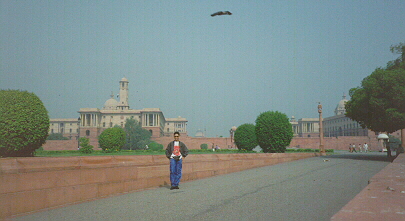 |
My first destination
is the Legislative Assembly building. I can see the imposing domes from
my hotel room window. The building is the main feature of New Delhi design
by Edwin Lutyens. Lutyens New Delhi is supposed to be a garden city with
wide straight vista, so essential for the ceremonial parades and processions.
His master plan was a vast hexagonal grid encompassing the Viceroy's house,
the old fort and a commercial area.
The huge crow flying over my head add some drama to this photo. |
| Then I saw India Gate, which the vista of The Rajpath terminates (well, the photo turn out to be blur due to lack of light) . So I walk towards its direction to observe it in detail. I walk the whole 3-kilometer of the ceremonial axis (Rajpath) towards the Viceroy's House, now Rashtrapathy Bhavan or the Presidential Palace. I took a lot of photos along the way. The remote control and the mini built in stand help a lot in putting myself inside the photos. |  |
| Since it is
still very early in the morning, it's quite pleasant to walk. The only
disadvantage was my shoe! The leather shoe that I worn was not meant to
be a walking shoe. From there I walk to the commercial centre which is
called Connaught Place. The buildings are in colonial style with it graceful
colonnades and arcade. There are a few newly constructed high-rises with
ultra modern design punctuate the city skyline. I was hoping to buy something
before returning to my hotel room but till 11.00am only a few shops start
to open for business. Apparently, there were shops open at the underground
bazaar. However, I could not muster my guts to go in. It does look a bit
dangerous for a first time tourist to venture alone.
By 11.30am I was back in my hotel room. I was exhausted. It's summer in Delhi. The temperature is hot and dry with the thermometer goes up to 45 degree Celsius. My meeting with Mr. Buphinder was only schedule at 12.30noon. So I order breakfast and watch a bit more Hindi musical program on TV. |
| I came from
Kuala Lumpur with a list of 16 short-listed candidates to be interviewed
while in Delhi. The interview session was planned to last 2 days. However
to my surprise, the agent had lined up a total of 34 candidates! After
a short discussion with them, I arrange my flight to be postponed to the
next available date, which is on Wednesday night. I started my interview
at around 2.00pm, barely able to browse through their C.V. I spend almost
an hour on each candidate although the slotted time was 15 minutes each.
How am I supposed to judge the capabilities of an architect with years
of experience in 15 minutes?!
I was really surprised that the architectural practice in India differs a lot from Malaysia although both are Commonwealth countries. It shows that both country had assimilates the English way of doing things differently. That's took a chunk of my time, try to find out how actually a project was carried out in India. The candidates were very eager to show off their talent and experience. Some of them had 15 to 20 years of experience. Some are visibly surprise that the person who are interviewing them are very young (especially with my punk hairstyle!). The last candidates leave my room at midnight after the hotel security called. The hotel has regulations against entertaining guest after midnight. I manage to finish only 14 of them. So the next day, the interview starts at 9.00 am. Again its end up at midnight. Generally, the 2nd day interview was brief. These were because I had already short-listed the candidates that I feel are suitable for the position of Project Architect, Design Architect, Auto CAD manager and Interior Designer. It is NOT an easy task. Besides the difference in ways of project being executed in India, there are some fundamentals that really worry me. Not one of the candidate that I had interviewed is aware of the 32 clauses of contract, which are THE most important document in a project. In Malaysia, this 32 clauses is the one things that separates an Architect from Technical Assistant, Draughmen or Designer. I think, due to the economic situation in India, not many architects had the opportunity to get involve in big project like their counterpart in Malaysia. The most experience one in India also only involve in some small scale interior design work, single residential project, modest scale hospitals, 8 storey `high rise’ project, urban design (mostly conceptual), farm houses and factories. I'm not trying to undermine them here, but I really feel sorry for them. Just imagine, substantial parts of their portfolio are toilet's details! Not many of them come prepared with a presentable (to my standard) portfolio. Some brought along very old and fragile looking rolls of blueprint. Another thing that caught my attention is the size of their certificates. Huge! I eat very
little during the interview sessions. Besides being careful not to upset
my stomach and to avoid non-halal food, I was also too engrossed with the
interviews. I take some fruits and tea. Later after I finished my interview
Mr. Bhutani invites me to his house because he is worried that I could
not have a decent meal.
|
| Mr. Bhutani
recommends that I go and visit Agra on Tuesday. We went to the train station
to book a ticket. I things strike me was there were not many women in the
station. And I am sure I will not know my way around without Mrs Bhutani
helps. Unfortunately, all trains tickets were sold out. I only manage to
book a place on a bus tour organize by the India Tourist Development Authority.
The rest of the day was spent watching Hindi program on TV.
The bus leaves the hotel at 7.00am. It was a 4 and a half-hour uncomfortable journey through India hinterland. There were about 25 of us in the bus. We stop for breakfast at one of the government run restaurant (it seems to me that there are a lot of `government run’ enterprises). I did not eat anything because the people there cannot explain to me the ingredient in the food. |
 |
The first stop in Agra was Sikandra, the tomb of Akbar. A very helpful tour guide joined us and brief us the history of Agra and the tourist attractions in this ancient city. The `high light’ of the tour at Sikandra was when the khadim called out a prayer in the mortuary chamber, deep inside the building that echoes and lingers at least 13 seconds. It raised the hair on the back of my neck! |
| Next stop, TAJ MAHAL. I've been looking forward to visit this architectural wonder since I learn about it in history class. This was intensified after visiting other Mughal monument in Lahore and learned about the tragic history behind the building of Mumtaz Mahal mausoleum. This masterpiece of the Emperor Shah Jahan is no doubt THE most beautiful building in the world. No word can describe how I feel when finally I was able to TOUCH this `monument to conjugal love’. Fascinated to it's beauty. Intrigue by its history. As Francois Bernier put it `The Taj Mahal had better claim to count among wonders of the world than the shapeless masses of the pyramids of Egypt’. |
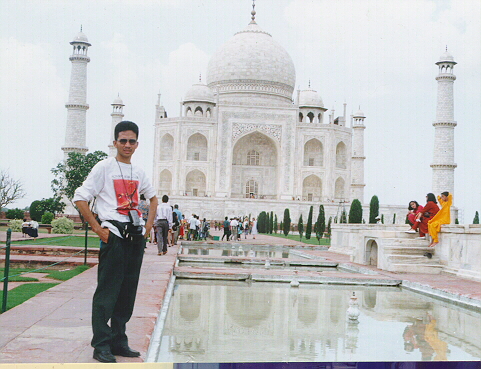 |
| When the guide
start explaining about the architectural wonders of the building, I started
feeling ashamed of myself as a modern day architect. How thoughtful were
the architects and craftsmen of that time! Among the wonders that were
highlighted by the guide were the skills of the calligrapher. It was evident
in the way they placed the verses from The Koran in such perfect proportion
that they seem to be of one size despite the changing perspective of the
areas in which they are located. The letters of inscriptions create a sense
of uniformity because they took recourse to a simple device of optical
illusions. Another details are how the centre of the gravity of the four
minarets is away from the centre so in the event of the minarets collapsing,
it will fall away of the main building!
The details of managing a project of such vast scope are mind boggling. Raw materials had to be procured from the desert of Rajasthan and from places as far as Persia and Afghanistan, Burma and Kashgar, thousands miles away and carried to Aggra. There was marble from mines at Makrana, there was yellow amber from Burma, lapis lazuli from Afghanistan, jade from China and other stones such as coral, chalcedony, green beryl, jasper, amethyst, agate and onyx from various regions of India. All this marble and semi precious stone would have to be checked for quality and than stored and guarded until they were required. A regular check would have had to be maintained on their quantity and used, so supply kept pace to the consumption. Accounts had to be prepared and maintained. The work of skilled craftsmen of many different guilds had to be co-ordinated. Managing the work force and the needs of so many varied artisans and workers would have required organization skills of an extremely high order. And this was in 1635! And for us modern day architects, even with latest technology available, putting up a simple residential building also were not done properly. The visit was a very good lesson to me. The reflection of the white marble building on the turquoise water of the elevated marble pool is something to cherish forever. The inner mausoleum was closed to visitors. The only part, which was not symmetrical in the whole complex, is the cenotaph of Emperor Shah Jahan and his Queen Mumtaz Mahal. Shah Jahan tomb was not planed for this building. An octagonal screen of unbelievable beauty surrounds the cenotaphs. It consists of single pieces of fretted marble set in marble frames decorated by fantastically design pietra dura inlay. |
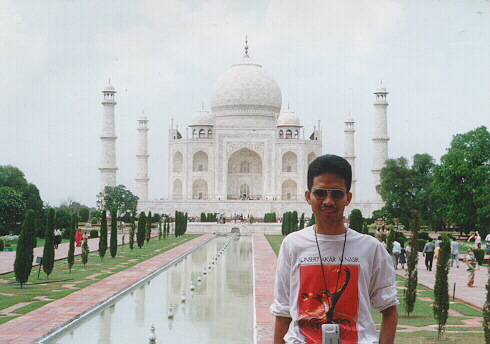 |
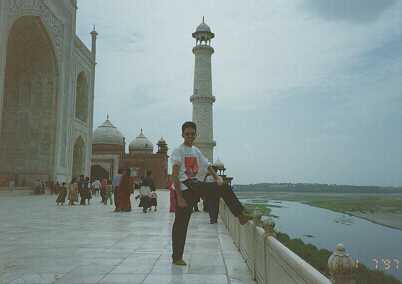 |
| I wish I could
stay in the building longer. Alas, we had to make a move to our next destination,
which was the Agra Fort. We had our lunch at a government run restaurant.
I didn't eat because the waiter fails to explain to me the menu. I was
trying to order a vegetarian food. I had to be vegetarian in India because
I'm not sure meat product are `Halal’ or not. It's easier (I thought) to
ask for vegetarian food than `Halal’ food without much `interrogation’.
However, it wouldn't help if the waiter is unable to understand English!
So, I survive on mineral water and Mirinda orange (I don't like the taste
of Indian Coke).
Since the beginning of the tour until I was about to board the bus, I was assaulted by a barrage of souvenir seller. I'm one of the `stupid tourists’ who are unable to say `no’. So by the time I sat down in the bus, my hands are full with postcards, fans fake marble boxes, stone necklace etc. Agra Fort is only a short distance away from Taj Mahal. The Fort is similar to Lahore Fort and contains Macchi Bhawan (courtyard) Diwan-I-Am (Hall of Public Audience), Diwan-I-Khas (Hall of Private Audience), Daulatkhana-I-Khas (Royal Residence) and Hammam (Royal Bath). Sheesh Mahal (Palace of Mirrors) and Moti Masjid (Pearl Mosque) were closed for restoration. I imagine the Sheesh Mahal were similar to the one in Lahore Fort. The highlight of the tour is Daulatkhan-I-Khas (Royal Residence). Its Thambi Khana or parlor is the gem in this imperial diadem. Originally, It was decorated with precious and semi-precious stone inlays in floral and geometrical patterns. The entire precious stone inlay was looted and most of the semi-precious stone work was damaged. A small portion was restored to its former glory. Projecting beyond the walls is the Jasmine Tower. I feel tranquil when I gaze from Jasmine Tower towards the Taj Mahal `floating’ in the distance. This is where Shah Jahan last saw the monument to his greatest love in a small mirror set in a marble pillar of the prison in the fort, where he had been put away by his own son, Emperor Aurengzeb. Again we had to rush back to our bus. We stop at one of the government run (again!) souvenir shop. They show us the demonstration on how the marble craft had been repeated in modern day furniture such as table top, chairs, boxes, plate, knick-knack etc. All were sold at cut-throat price. I settle for fake marble souvenir! Than the journey back: 4 and a half-hour of uncomfortable ride back to Delhi. I reach the hotel at 11.30pm. Exhausted but very happy. That night my sleep was filled with dreams that I cannot recalled but had everything to do with the history of the Mughal era. Wish you were there to experience it with me! |
 |
My last day
in Delhi was spent shopping at Conought Place. Mr. and Mrs. Bhutani accompanied
me to the various shops. I bought most of the souvenir at the government
run Central Cottage Industries Emporium. Although the price was slightly
higher than the one found at the bazaar (plus taxes some more), at least
the prices were fixed. I don't like to haggle. It took at least 4 steps
before the item was officially mine (typical Indian bureaucracy). Most
souvenirs are for my office staff (40 of them). I bought for myself a leather
briefcase and a star ruby stone. I bought 2 pieces of saree cloth, one
for my mother and the other one for my future wife (whoever she may be;
that's the beauty of saree; size does not matter:-). I also manage to visit
the Jain Lotus temple (see photo). It was quite an experience.
Finally it was time to say goodbye to India. I'm sure I will be back, judging from the turnout of this trip. I still had not explored Old Delhi. I haven't visited Shahjahanabad, Delhi Fort, Qutub Minar, Jama Mosque etc. Furthermore, I have not visited Fatihpur Sikri. Singapore Airline `Big Top’ touches down at Changi Airport at 8.00am. I took the connecting flight to Kuala Lumpur at 9.00am. A few days after the trip, my mind is still in the heart of the Mughal Kingdom. |
|
|
|
|
 muluk@ppp.nasionet.net
muluk@ppp.nasionet.net